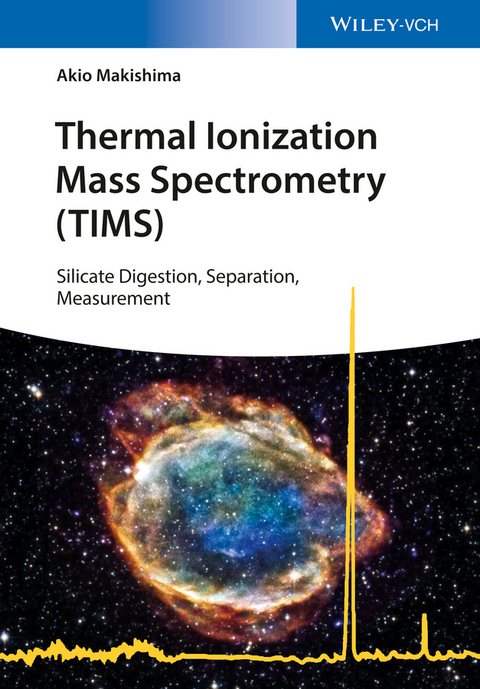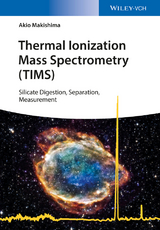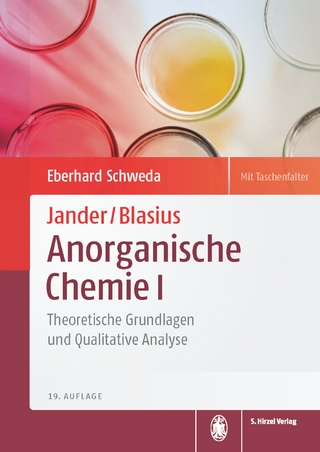Thermal Ionization Mass Spectrometry (TIMS)
Wiley-VCH (Verlag)
978-3-527-34024-8 (ISBN)
Akio Makishima is professor of Analytical Geochemistry Division in the Pheasant Memorial Laboratory (PML), Okayama University at Misasa, Japan. He obtained his Ph.D. from Tokyo University under supervision of Professor Akimasa Masuda. After three years in the Analytical Research Center of Nippon Steel Co. Ltd under supervision of Dr. Koichi Chiba, he was appointed assistant professor in Misasa, and finally obtained the professorship. He has been working with Professor Eizo Nakamura, and authored over 60 scientific publications, most of which are related to developing new analytical techniques using TIMS, ICP-QMS and MC-ICP-MS.
PREFACE
PART I. INTRODUCTION
OVERVIEW OF ATOMS, ISOTOPES, AND BULK/SPOT ANALYSES
The atom, isotope and mass spectrometry
Bulk analysis and spot analysis
Electron probe microanalysis
Secondary ion mass spectrometry
Laser ablation-inductively coupled plasma mass spectrometry (LA-ICP-MS)
Radioactive decay
OVERVIEW OF MASS SPECTROMETRY
Characterization of mass spectrometry by the ion source
Characterization of mass spectrometry by the mass separator
CHARACTERIZATION OF ELEMENTS BY THEIR BEHAVIOUR IN HF SOLUTION
BRIEF OVERVIEW OF ANALYTICAL GEOCHEMISTRY
Major element geochemistry
X-ray fluorescence spectrometer
Loss on ignition and ferric/ferrous ratio of iron
The classification of the igneous rock sample
Trace element geochemistry
Determination of mass fractionation
Age dating
Age dating by radioactive isotopes
Extinct nuclides
An isochron or a mixing line?
Radiogenic isotopes for geochemical tracers
PART II. BASIC PRINCIPLES IN MASS SPECTROMETRY
VACUUM TECHNIQUES AND ION DETECTION
Basic knowledge on vacuum
Conversion table of the vacuum unit
When you touch the vacuum and electric equipment
Speed of gas molecules
Pirani gauge
Penning gauge
Ion gauge
Rotary pump
Oil diffusion pump
Turbo molecular pump
Ion pump
Cold trap (cryopump)
Photo-electron multiplier
Secondary electron multiplier and ion counting system
Operation of SEM
Faraday cup
PRINCIPLES OF IONIZATION OF ELEMENTS AND MASS SEPARATION
Principle of thermal ionization (TI)
Inductively coupled plasma (ICP) source
Ionization by sputtering phenomena
Principle of mass separation by sector magnetic field
Principle of quadrupole (Q-pole) mass filter
Mass resolution
Abundance sensitivity
Mass discrimination correction
MASS SPECTROMETERS
Thermal ionization mass spectrometer
Inductively coupled plasma source Q-pole type mass spectrometry (ICP-QMS)
Sector-type ICP-MS (ICP-SFMS)
Multicollector ICP-MS (MC-ICP-MS)
Secondary ion mass spectrometer (SIMS)
A single zircon dating
Multicollector high resolution SIMS (high resolution-SIMS or HR-SIMS)
PART III. BASICS AND PRINCIPLES OF CHEMICAL SEPARATION
ERRORS
Average and standard deviation
The normal population
The standard error
ISO suggestion
Modified Savitzky-Golay method
Variance, covariance and correlation coefficient
Weighted average, variance and covariances
The least square method
CLEAN ROOMS
MATERIALS USED IN LABORATORY
Glassware
Plastics
Water
Azeotrope
Physical and chemical properties of acids
HF
HCl
HBr
HNO3
HClO4
Purification of acids
Alkali reagents
Ammonia water
TMSC
POWDERING, WEIGHING, AND ISOTOPE DILUTION TECHNIQUE (ID)
Powdering
Weighing
Isotope dilution method (ID)
Error magnification
ION EXCHANGE CHROMATOGRAPHY
Cation and anion exchange chromatography
Prewash of ion exchange resins
Other reagents and purification
The HIBA solution
DCTA and pyridine
EichromTM resins (liquid exchange chromatographic resins)
Some tips in the column chemistry
SAMPLE DIGESTION TECHNIQUES
HF+HClO4 digestion in ambient pressure (an "ultrasonic method")
HF digestion in high pressure (a "bomb method")
Microwave digestion method
Carius tube digestion for Os separation
HPA (High Pressure Asher) digestion method
Fusion
A digestion method using NH4F
STANDARD SAMPLE DIGESTION AND ANALYTICAL METHODS BASED ON CHARACTERISTICS OF ELEMENTS
FLUORIDE FORMATION IN SILICATE DIGESTION AND COPRECIPITATION ISSUES
Formation of fluorides in basalt digestion by HF-HNO3 digestion and coprecipitation
Formation of AlF3 in rhyolite decomposition by bomb digestion and coprecipitation
Coprecipitation of fluorophile/oxophile elements
Ti addition method
Summary of element determination methods
Drawbacks of Al and Mg addition methods
PRACTICAL SEPARATION METHODS FOR SR-ND-PB-HF AND U-TH-PB
Sequential separation method of Rb, Sr, Sm and Nd
Separation method of Pb
Separation method of Lu and Hf (plus Sm and Nd)
Sequential separation of large amounts of Sr-Nd-Pb
Determination of Sr, Nd, Hf and Pb isotope ratios and 55 elements
Sequential U, Th and Pb separation method
TIMS ANALYSES FOR RB-SR, SM-ND, AND U-TH-PB
The Rb isotope ratio determination for ID-TIMS
The spike-ratio determination of Sr by TIMS
The 87Sr/86Sr ratio measurement by MC-ICP-MS
The Sm isotope ratio determination for ID-TIMS
The spike-ratio determination for Nd by TIMS
The 143Nd/144Nd ratio measurement by MC-ICP-MS
The 176Hf/177Hf ratio measurement by MC-ICP-MS
The Pb isotope ratio determination by TIMS using the double spike method
The Pb isotope ratio determination by MC-ICP-MS using the double spike method
The determination of 234U/238U and 233U/238U by TIMS
The determination of 234U/238U and 233U/238U by MC-ICP-MS
The determination of 230Th/232Th and 229Th/232Th ratios by TIMS
The determination of 230Th/232Th and 229Th/232Th ratios by MC-ICP-MS
PART IV. ANALYTICAL TECHNIQUES IN TIMS
TIMS ANALYSIS
The peak jumping method
The dynamic multi-collection
Matrix amplifier
Spike-ratio measurement
The double spike technique
Importance of background and gain factor measurements
Theoretical errors of Faraday cups
Amplifiers' time lag or amplifiers time constant (tau)
Accurate isotope ratio measurement of two-isotopic element by TIMS
Filament degassing (outgassing)
Running cost of TIMS
Some tips in TIMS
PART V. APPLICATION OF TIMS TO ISOTOPE ANALYSIS OF EACH ELEMENT
PRECISE ISOTOPIC MEASUREMENT OF LI BY TIMS
Introduction
Separation of Li
Loading and TIMS of Li
Across-arc variation of Li isotopes in lavas from the Izu arc, Japan
MC-ICP-MS for Li
POTASSIUM ISOTOPE DETERMINATION BY TIMS
Introduction
Separation of K
Loading and TIMS of K
MG SEPARATION AND DETERMINATION USING TIMS
Introduction
Standard reference materials for Mg
Separation of Mg
Loading and mass spectrometry of Mg by TIMS
The intermediate precision by MC-ICP-MS
CA ISOTOPE DETERMINATION USING TIMS
Introduction
Separation of Ca and Fe (and Mg) for TIMS
Loading and TIMS technique of Ca
TOTAL EVAPORATION TIMS (TE-TIMS) FOR 226RA DETERMINATION
Ra separation from silicate samples
Separation of Ra
Total evaporation TIMS (TE-TIMS) of Ra
Calculation of 226Ra abundance
MC-ICP-MS of ID of 228Ra/226Ra using multi-ion counting detection
APPLICATION OF TIMS TO LA-BA AND LA-CE DECAY SYSTEMS
Introduction
La-Ba separation
Ba isotope analysis by TIMS
La-Ce separation
Ce isotope analysis by TIMS
ULTRA-PRECISE MEASUREMENT OF 142ND BY TIMS
Introduction
Chemical separation of Nd
Analytical technique of TIMS
CLASSIC DETERMINATION OF REE BY ID-TIMS
Introduction
Separation and mass spectrometry of each REE
La
Ce
Nd and Sm
Eu
Gd
Dy, Er, Yb and Lu
TI ISOTOPIC DETERMINATION BY TIMS
Introduction
Separation of Ti
Loading and mass spectrometry of Ti by TIMS
Determination of the Ti isotope ratio by MC-ICP-MS
DETERMINATION OF ZR ISOTOPIC RATIO BY TIMS
Introduction
Chemical separation of Zr
Loading and TIMS of Zr
MC-ICP-MS of Zr
APPLICATIONS OF TIMS TO 235U-231PA DISEQUILIBRIUM STUDIES
Introduction
The 233Pa spike preparation
The Pa purification method for the sample
TIMS of Pa
DETERMINATION OF V ISOTOPIC RATIO BY TIMS FOR ID
Introduction
Chemical separation of V
Loading and mass spectrometry of V
Determination of V isotopic ratio by MC-ICP-MS
ULTRA-PRCISE MEASUREMENT OF 53CR BY TIMS
Introduction
Column chemistry for separation of Cr
TIMS for Cr
PRECISE ISOTOPIC ANALYSIS OF MO BY P-TIMS, N-TIMS and MC-ICP-MS
Introduction
Positive-TIMS techniques
Negative-TIMS techniques
Mo isotope measurement by MC-ICP-MS
APPLICATION OF TIMS TO HF-W STUDIES
Introduction
Tungsten separation from metal phases
Tungsten separation from W-poor materials (silicate phases)
Tungsten measurement by N-TIMS
Hafnium measurement by P-TIMS
DETERMINATION OF FE ISOTOPIC RATIO BY TIMS for ID
Introduction
Chemical separation of Fe
Loading and P-TIMS of Fe
Loading and N-TIMS of Fe
MC-ICP-MS for Fe
DETERMINATION OF RU ISOTOPIC RATIO BY TIMS FOR ID
Introduction
Chemical separation of Ru
Loading and N-TIMS of Ru
Application of N-TIMS TO RE-OS and PT-OS SYSTEMS
Introduction
N-TIMS of Os
N-TIMS of Re
Os purification by CCl4, CHCl3 and Br2
Os purification by micro-distillation
Re purification
90Pt-186Os system
DETERMINATION OF IR ISOTOPIC RATIO BY TIMS FOR ID
Introduction
Chemical separation of Ir
Loading and mass spectrometry of Ir
DETERMINATION OF NI ISOTOPIC RATIO BY TIMS FOR ID
Introduction
Chemical separation of Ni
Loading and mass spectrometry of Ni
DETERMINATION OF CU ISOTOPIC RATIO BY TIMS FOR ID
Introduction
Chemical separation of Cu
Loading and mass spectrometry of Cu
APPLICATION OF TIMS TO PD-AG
Introduction
Chemical separation of Ag
TIMS of Ag
TIMS of Pd
Application of MC-ICP-MS to 107Pd-107Ag
DETERMINATION OF ZN ISOTOPIC RATIO BY TIMS FOR ID
Introduction
Chemical separation of Zn
Loading and mass spectrometry of Zn
DETERMINATION OF CD ISOTOPIC RATIO BY TIMS FOR ID
Introduction
Chemical separation of Cd
Loading and mass spectrometry of Cd
PRECISE ISOTOPIC MEASUREMENT OF B BY P-TIMS WITH PIGGY-FARADAY CUPS AND APPLICATIONS TO ANALYTICAL GEOCHEMISTRY
Introduction
Suppression of B volatilization in HF solution, and purification of B with low blanks
Measurement of B by TIMS
Development of piggyback Faraday cups for static multicollection of Cs2BO2+ ions for precise boron isotope analysis
Application of B isotope ratios to mantle/crust recycling at the Izu subduction zone
Application of B isotope ratio measurements by MC-ICP-MS
DETERMINATION OF GA ISOTOPIC RATIO BY TIMS FOR ID
Introduction
Chemical separation of Ga
Loading and mass spectrometry of Ga
DETERMINATION OF IN ISOTOPIC RATIO BY TIMS FOR ID
Introduction
Chemical separation of In
Loading and mass spectrometry of In
DETERMINATION OF TL ISOTOPIC RATIO BY TIMS FOR ID
Introduction
Chemical separation of Tl
Loading and mass spectrometry of Tl
DETERMINATION OF SN ISOTOPIC RATIO BY TIMS FOR ID
Introduction
Chemical separation of Sn
Loading and mass spectrometry of Sn
DETERMINATION OF SB ISOTOPIC RATIO BY TIMS FOR ID
Introduction
Chemical separation of Sb
Loading and mass spectrometry of Sb
DETERMINATION OF S, SE, AND TE ISOTOPIC RATIO BY TIMS FOR ID
Introduction
Chemical separation of S, Se, Te
Loading and mass spectrometry of S, Se, Te
DETERMINATION OF CL AND BR ISOTOPIC RATIO BY TIMS FOR ID
Introduction
Chemical separation of Cl and Br
Loading and mass spectrometry of Cl and Br
DETERMINATION OF TA ISOTOPES BY TIMS
Introduction
Chemical separation of Ta
Loading and mass spectrometry of Ta
REFERENCES
| Erscheint lt. Verlag | 20.1.2016 |
|---|---|
| Verlagsort | Berlin |
| Sprache | englisch |
| Maße | 170 x 244 mm |
| Gewicht | 818 g |
| Themenwelt | Naturwissenschaften ► Chemie ► Analytische Chemie |
| Naturwissenschaften ► Geowissenschaften ► Geologie | |
| Technik ► Maschinenbau | |
| Schlagworte | Analytical Chemistry • Analytische Chemie • Chemie • Chemistry • earth sciences • Geochemie • Geochemie, Mineralogie • Geochemistry & Minerology • Geochemistry & Minerology • Geowissenschaften • Massenspektrometrie; Handbuch/Lehrbuch • materials characterization • Materials Science • Materialwissenschaften • Werkstoffprüfung |
| ISBN-10 | 3-527-34024-6 / 3527340246 |
| ISBN-13 | 978-3-527-34024-8 / 9783527340248 |
| Zustand | Neuware |
| Haben Sie eine Frage zum Produkt? |
aus dem Bereich




